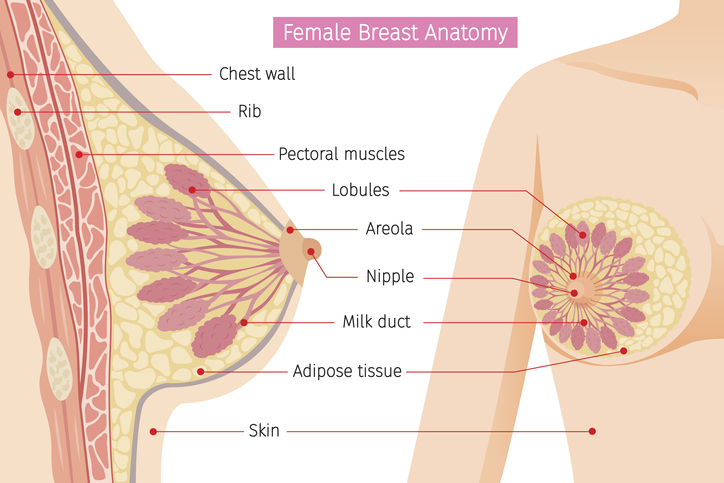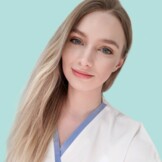- ROZTOČIL, Aleš and Pavel BARTOŠ. Modern Gynaecology. Prague: Grada, 2011. ISBN 978-80-247-2832-2
- solen.sk - Mammography - possibilities of use by a general practitioner. Solen. Katarína Mlyneková
- nierakovine.sk - October is pink
- pubmed.ncbi.nlm.nih.gov - Awareness and current knowledge of breast cancer. Muhammad Akram, Mehwish Iqbal, Muhammad Daniyal, Asmat Ullah Khan
- nationalbreastcancer.org - Breast cancer awareness month
Breast self-examination: how to prevent and care for breast health?

Home breast self-examination is the foundation of women's health prevention. How does the examination proceed step by step and what is important to focus on?
Article content
We offer you interesting information about breast self-examination, possible manifestations of the disease and overall prevention. Read with us.
Basic information about breasts
The breast is internally made up of the mammary gland, milk ducts and fatty tissue determining the size and shape of the breast.
The milk ducts emerge from the mammary gland and converge together and then exit out through the nipple.
The nipple and hyperpigmented breast are located in the centre of the breast. Below the breast are the pectoralis major muscle, pectoral fascia and rib bones. The subclavian and axillary lymph nodes are located close to the breast.
A basic minimal knowledge of breast anatomy is useful to increase the level and effect of breast self-examination.

Breast self-examination
Breast cancer is the most common cancer in women.
Regular examination by a physician and home breast self-examination are essential to detect the disease as early as possible and to significantly improve the prognosis of the disease.
After the age of 20, women should regularly self-examine their breasts at home.
Doctors recommend self-examination every two months after the age of 20 and every month after the age of 30.
It is important for a woman to know her breasts: their shape, size, surface pigmentation and internal structure. A self-examination can then more easily detect any abnormalities.
The ideal time for the examination is 3 days after the end of the menstrual period, as the breasts are not much affected by hormonal changes in the cycle.
In addition to the regular monthly self-examination at home, a regular preventive examination by a gynaecologist (once a year) is necessary, even if the woman has no health problems.
Breast health prevention also includes sonography/mammography of the breasts, which is prescribed by the gynaecologist during the preventive check-up.
The breast self-examination is brief, taking approximately 5 to 7 minutes.
There are now more precise procedures, but the primary goal is a thorough examination of the entire breast area. In addition to the breast tissue itself, nearby lymph nodes are checked.
Step-by-step self-examination
Take off your outer clothing, including your underwear - bra.
Stand in front of a mirror with sufficient lighting for your body and the room.
Do not let anyone or anything disturb you.
Follow these steps:
- Begin the examination with an aspect - a gaze examination.
- In front of the mirror, examine the nipple for any change in size, surface texture, redness, pigmentation of the areola or nipple discharge, or excessive nipple retraction. Compare the breasts with each other.
- Then raise both hands behind your head and again examine the breasts by eye, including the lymph nodes and axillae. Slowly rotate from left to right.
- This is followed by palpation.
- In front of the mirror, grasp one breast with your hand and palpate it thoroughly, using especially the bellies of the three middle fingers.
- Palpation movements are divided into three basic types:
- Horizontal (side to side)
- Vertical (bottom to top)
- Circular movement, contracting around the nipple
- Another type of palpation is a ray-like movement towards the nipple or gentle squeezing of the breast tissue.
- All types of palpation should be used in the examination.
- If a lump, bump or hardening is found, it is necessary to be alert.
- The last stage of the examination is palpation in the supine position.
- Lie on your back on a soft pad and place a pillow under your head.
- The hand on the side of the breast being examined is behind the head and the other hand palpates the breast.
- Then place the hand on the side of the breast to be examined along the body and repeat the palpation.
- In addition to the breast itself, it is also necessary to focus on the subclavian and axillary lymph nodes.
- Repeat the same procedure on the opposite breast.
Not every lump on the breast has to mean cancer. But every lump must be examined by a doctor.
If you find a hard lump, there is no need to panic. It may not be cancer. It may be a benign mass in the form of a cyst, lipoma, papilloma, fibroid inflammation or swollen lymph node.
However, it is necessary for the gynaecologist to make a professional diagnosis and subsequent determination of treatment.
Increased but physiological breast tenderness and tightness can also be felt during premenstrual syndrome (PMS) or at the time of ovulation. Sometimes the tenderness is caused by inappropriate bra choice or as a result of excessive exercise of the pectoral muscles.
Interesting information in the article Breast Cyst.

What symptoms to watch out for?
It is important to look for specific signs and symptoms that would suggest a possible breast health problem.
You need to watch out for:
- Change in breast skin color
- Change in breast texture
- Change in pigmentation of the breast socket
- Enlargement/shrinkage of one breast
- Presence of a lump/nodule
- Presence of a dimple
- Nonspecific breast tenderness
- Nipple discharge (lymphoid, bloody, brown...)
- Nipple retraction not previously noted

Prevention of breast health
The basic prevention of women's overall health is regular preventive examinations by a gynaecologist, undergoing instrumental breast examinations (sonography, mammography), a complete balanced diet, intake of necessary vitamins and minerals, sufficient protein intake, regular physical activity, avoidance of sexually transmitted diseases and adherence to treatment of other possible health diagnoses.
For specific prevention of breast health, it is advisable to follow certain measures, especially if there is a family history of breast disease.
As part of breast health prevention, pay attention to:
- Limit smoking and alcohol consumption
- Maintaining a reasonable body weight
- Promoting hormonal balance
- Adequate intake of vitamins (especially B vitamins)
- Regular check-ups with a gynaecologist
- Regular home self-examination
- Immediate treatment of a health problem
- Take an interest in family history
- Choosing an appropriate, sufficiently loose bra
- Adequate breast support during exercise
Gynaecological preventive examination
Once a year, every woman should have a preventive examination by her gynaecologist, even if she has no health problems. The preventive examination includes a professional examination of the breasts by sight and touch.
The doctor performs a palpation examination per vaginam and uses a sonograph to view the internal structures of the female organs. A control internal swab is taken, which is then evaluated in the laboratory.
He or she indicates an instrumental diagnostic examination (sonography or mammography), which may be covered by health insurance to a specified extent.
Sonography
Every woman between the ages of 20 and 40 should have a sonogram every two years. This is a short, painless examination in the supine position, during which the doctor passes the head of an applicator over the breast.
Using a special transparent gel applied to the patient's body and ultrasound waves from the sonography, the internal structure of the breast tissue can be seen on a monitor screen.
Mammography
A woman aged 40 years or older should have a mammogram every two years. This is a diagnostic instrumental examination using soft X-rays that show the internal tissue of the breast.
The examination involves a brief squeezing of the breast, which can be uncomfortable or even painful. However, it is not harmful to the woman.
Breast cancer prevention and risk education
October is internationally recognised as Women's Health Awareness Month and the risks of breast and cervical cancer.
The colour pink during this month draws attention to the need for preventive gynaecological examinations and home breast self-examination. Pink October is also a symbol of solidarity with women who suffer from this cancer.
If a woman finds something that worries her during a self-examination, she should see a gynaecologist as soon as possible.
In addition to the colour pink, the symbol is a simple pink ribbon that is pinned to the outer garment. It symbolises femininity and hope.
Read also.

Interesting resources










